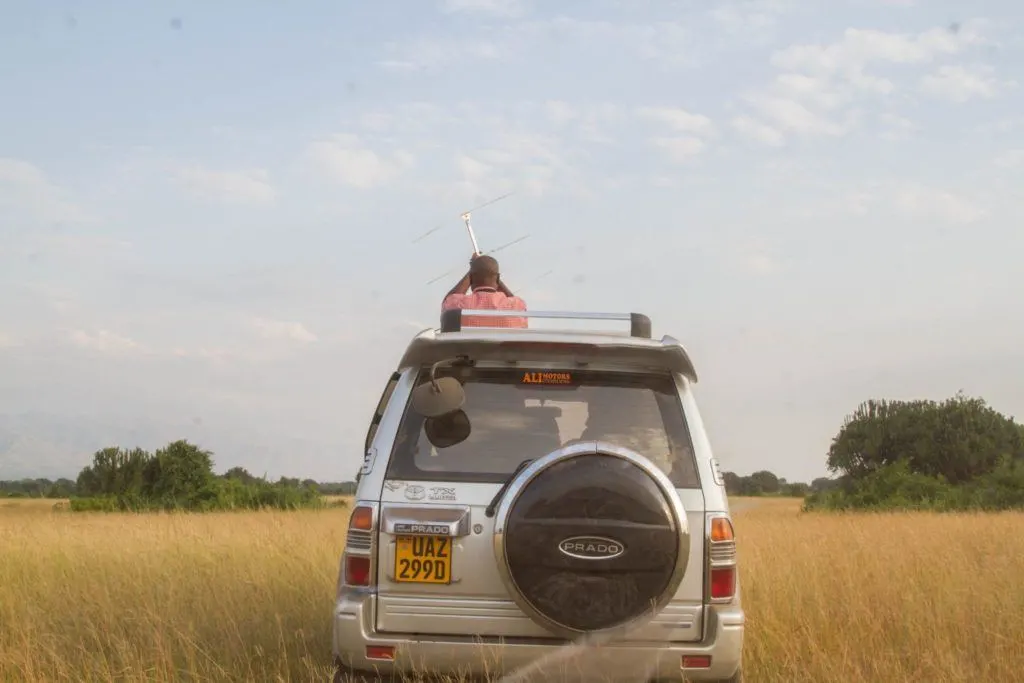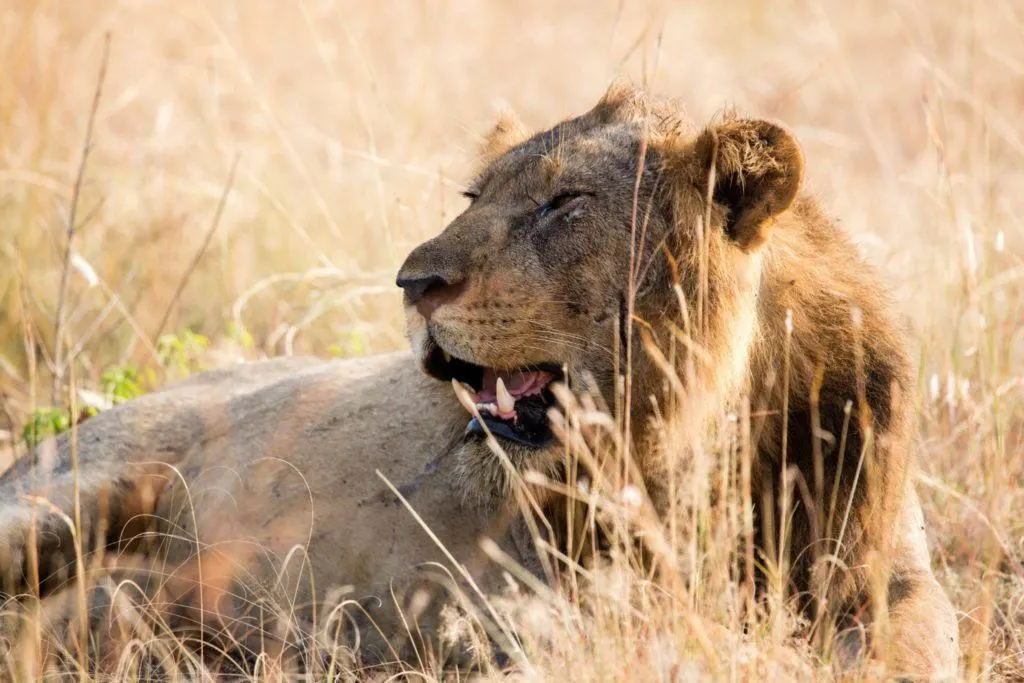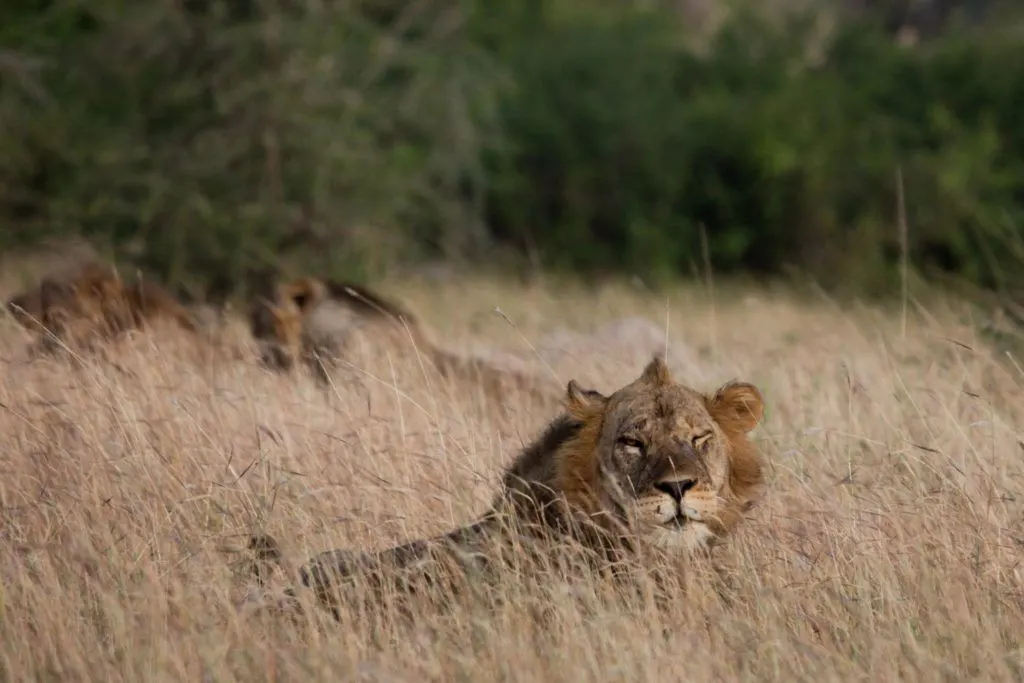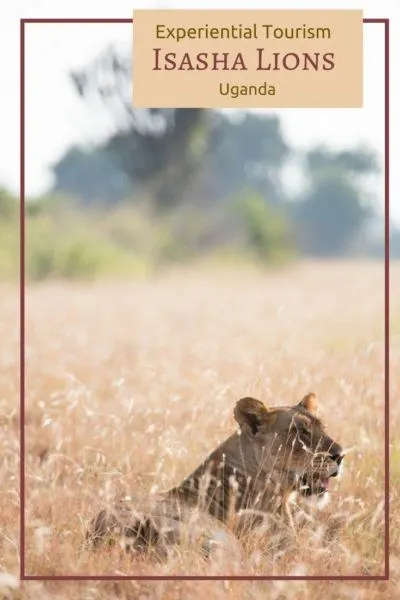Uganda’s Queen Elizabeth National Park is home to the amazing tree climbing lions of Isasha. It’s also the place to go on a lion trek. Load up the truck and get off road!
When I think of cat’s in trees, the first thing that comes to mind is a poor, crying cat up in a tree and and a fireman up on a ladder getting it down. Now, I’m not sure if this is a myth or not, but I can’t imagine that really happens. At any rate, the idea of large cats, like lions, climbing and living in trees seemed a little absurd.
So when I heard about the tree climbing lions of Isasha, I was pretty sure someone was pulling my leg. In Morocco we came across tree climbing goats and were horrified to see a roadside tourist attraction where the goats were tied into the tree. I was hoping this wasn’t going to be something like that experience. One thing was certain, we had to go to Queen Elizabeth National Park and see for ourselves.

Uganda’s Queen Elizabeth Lions
As it was, we saw plenty of lions in Queen Elizabeth Park. In the southern sector, called Isasha, the lions climb trees and hang out there during the day. We drove out there a few times, because in one tree there would be four to six lions just lying on the branches. They love to get out of the sun in the wide-spread Sycamore Fig trees, and they are pretty used to having a bunch of humans gawking at them all day long.
Have you always wanted to go on an African safari? See the best wildlife around the world? Check out these two podcasts and start planning your adventure!
Other drivers came up and saw us there, asked us what we had seen, waited for a few minutes, then left without waiting around to see what would come in next to drink.
Tracking the tree climbing lions in Isasha can be done easily on a self-drive along the Fig Tree Track. Be sure and follow all of the side tracks off the main road. Look carefully around the trees as you drive around them, the lions can be hard to spot. Take your time,watch for other trucks and don’t be afraid to ask about their sightings.
The park is large, so we recommend breaking it up into two different visits. Start in either the north or south, stay for a few days, then move to the opposite part of the park. We started in Isasha and then moved up to the north for the Kazinga channel and a completely different kind of lion trekking experience, this one with a guide.
The Uganda Lion Experience Trek
“$150 fine if you drive off track,” read the sign in the north of Queen Elizabeth Park. This came back to me unbidden when the researcher’s vehicle took a sudden left turn right through the high grass, with plenty of Ugandan Kob watching us as we sped by.
The day had not started out like we had hoped. It was Christmas morning, and we expected not to be able to even sign up for the lion tracking experience on a holiday. However, in the Ugandan parks it was business as usual, almost. There was one difference.

Christmas is a family day, so many of the Uganda Wildlife Authority rangers and other workers who were on-duty, just brought their families with them to work. We discovered this when at 7:30 sharp, the researcher we were supposed to be with all day, James Kalyewa, rode up in a car packed with his brother’s family.
James had thought that we would be in a large four wheel drive vehicle, like a Range Rover, and you could see the disdain on his face when he looked into our small RAV 4. He decided to keep riding with his brother, whose truck had a convenient sun roof he could hold his antenna out of in order to find the lion prides. Kicking off his shoes, he motioned for Jim and me to get back in the car and follow him.

The sun was just starting to rise, and the air was still somewhat cool, a perfect time to locate some lions. We drove out on the track that leaves the main road right there at the Kasenyi Gate. After about 15 minutes, and just as Jim and I are commiserating about signing up for this experience on a holiday, James’ brother goes off-road. Jim only hesitated a couple of seconds, and then, with a lopsided grin, off the track we followed. Knowing we were breaking the rules was only one of the reasons our hearts were beating so fast.

We drove and drove into the deep grass where there were no visible tracks. The lions know what they are doing. The jeep in front of us stopped a couple of times for James to take some readings, and finally his arm shot out of the passenger’s window pointing, pointing.

We didn’t see anything at first. Camouflage is an amazing thing. It never ceases to amaze me how such a large animal, and in this case four large animals, could just lie down and disappear right before your eyes. We were almost on top of them, only about eight feet away, when we saw them.
Why are the researchers collaring lions?
There were three females and one male. The male had a leather collar around his neck. James told us that the collars cost about $200 each and had to be replaced every two years.

Researchers were tracking the lions for a number of reasons, but one big one was that the lion population kept declining and no one knew why. Many were afraid that the canine distemper virus that had affected the Serengeti had made its way to Uganda, so the UWA set up the Uganda Carnivore Program to monitor large predators like lions, leopards, and hyenas.
They found out that the virus was not the culprit, but instead the lions were being poisoned by locals who feared for their cattle and other livestock. By continuing to monitor the predators, they have been saving lives.
The four cats we found on our lion tracking experience were lying in the grass, with a few splatters of blood on their fur, so it was obvious they had just eaten. Looking for the kill, we found a bloated hippo carcass that had been breakfast. James was a little perplexed how the hippo got so far from the water. As far as we could see there were no other hippos in the vicinity.
The lions got up, walked around our cars, and then lay down again. They weren’t too worried about us being there, and didn’t seem inclined to go anywhere else. We stayed and watched them for a good forty minutes before starting our engines and taking off to other parts of the park.
Power Tip: Safaris are great learning opportunities for kids. Here is an absolute fantastic list of kids’ books about Uganda. Check it out!

Practical Information:
To do the lion tracking experience and go out with researchers, you must go to the tours office at the park at least the day before. They run almost every day of the year. For the lion experience, we were told we needed our own transportation to the gate but that we wouldn’t need it for the actual experience. Sign up for your tours as soon as you arrive at the park.
However, in the end we did need our own vehicle, so be prepared. According to the most recent UWA tariff sheet, the Lion (Predator) Experience is $150 per person. Tickets and payments must be arranged at the Park Headquarters.
Author Bio: Corinne Vail is a travel photographer, food lover, and a perpetual traveler who has been travel writing for over 14 years. For many years she lived overseas in Germany, Japan, Turkey, South Korea, and the Netherlands teaching the children of the US. military. She’s visited over 90 countries, and she’s not stopping anytime soon.


Jesús Pinilla
Thursday 19th of August 2021
Hi there! Very useful webpage indeed! Thanks for sharing. One question about self-driving through the National Parks. How do you manage to find your way through? I haven't been able to get any decent map and some say that signposts are not available. I would really appreciate any advise on this topic. Cheers!
Corinne Vail
Thursday 19th of August 2021
Usually there are not that many roads through a park. Most are circles and some you just go all the way one way and turn around and come back. We've never had any issues at all finding our way around.
Paul Nduhuura
Tuesday 21st of February 2017
Hello Marie, hello Tom, it's nice to hear that you would like to travel to Uganda. You are welcome to Uganda. I am Ugandan and willing to support you when you come. There are also many licensed travel agents that you can search out on internet. Just like Corinne said, Ugandan national parks are not crowded. There are over 10 parks and game reserves in Uganda offering diversity of wildlife packages.
Tom Bartel
Sunday 19th of February 2017
Thanks so much for this story, Corinne and Jim. Terrific photos, too. Another experience we have to add to our list.
Corinne Vail
Sunday 19th of February 2017
Tom, Yes, it's a good one. We loved getting close and we certainly loved the off-roading to get there.
Jim Vail
Saturday 18th of February 2017
Thank you Taris, I hope you do get to travel soon!
marie
Saturday 18th of February 2017
I really want to travel to Uganda! I met the Ugandan tourist board at a travel fair and was immediately enchanted by the country. I would love to know, is it very crowded with tourists here?
Corinne Vail
Saturday 18th of February 2017
Marie, It is not at all crowded with tourists. Sure, in the most popular places you run into some, but no, not like Europe tourists. It's quite nice! Go! We absolutely cannot say enough about this gorgeous country and its people!